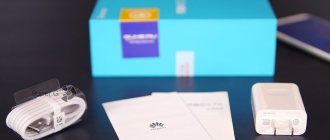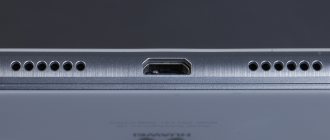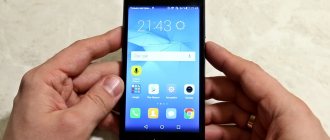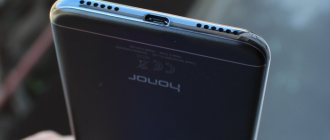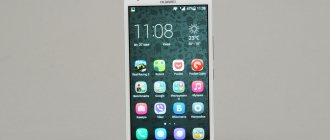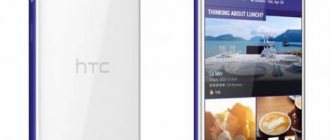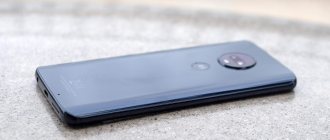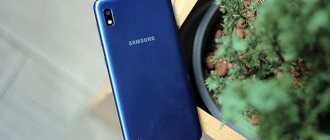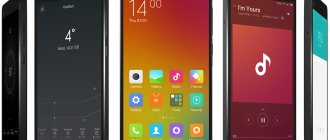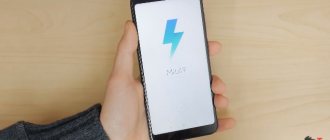Equipment
The Honor devices given to journalists for testing do not spoil them with complete packages. Therefore, I’ll just list what you can find in the box when unpacking the Honor 8 Lite:
- telephone
- Charger
- USB cable
- quick user guide
- warranty card
- SIM card removal tool
There is no wired headset included, so we select something of our own. I never get tired and will never stop recommending headphones from Xiaomi - these are these. They cost 16 bucks and are a lot of fun.
Processor and memory
Traditionally, Huawei installs processors in its smartphones that it produces itself. The same applies to Huawei Honor 8 Lite – it has an eight-core HiSilicon Kirin 655 chipset with a maximum clock frequency of 2.12 GHz. The Mali-T830 accelerator is responsible for the graphics, and as for the memory, 4 GB of RAM and 32 GB of built-in create a very good tandem, which is sufficient for any everyday interaction with the gadget. In the AnTuTu benchmark, the Honor 8 Lite smartphone scored 56.5 thousand points, which is not the highest, but sufficient. However, this model cannot be called a gaming model, because not every game will work without problems at the maximum graphics settings. But don’t worry: the smartphone will handle 90% of all games without question, without heating above 40 degrees Celsius.
Design
The continuity of the Honor line is visible to the naked eye. The device is very similar to its grandfather, Honor 6, and its contemporary, Honor 8.
The appearance is calm, without frills, but also without failures. You just take a smartphone out of the box, set it up and use it. You don’t get any particular euphoria, but there’s nothing to dig into either. This is how our hero came out.
Traditionally, there are no touch buttons under the screen. They are part of the interface, when necessary (though not always) they hide and stop eating away the useful area of the screen.
There is an advantage to this approach - it’s convenient to watch videos and play on a smartphone. You calmly hold the device with your hands in a horizontal position and there is no risk of accidentally touching the touch button at the most inopportune moment.
They say there is glass on the front and back. What exactly - history is silent. Both panels have a 2.5D effect, so the design is streamlined, pleasant, and fits very well in the hand.
| Length | Width | Thickness | Weight | |
| Honor 8 Lite (5.2'') | 147,2 | 72,9 | 7,6 | 147 |
| Honor 8 (5.2'') | 145,5 | 71 | 7,5 | 153 |
| Honor 6X (5.5'') | 150,9 | 76,2 | 8,2 | 162 |
| Xiaomi Redmi 4 Pro (5.2'') | 141,3 | 69,6 | 8,9 | 156 |
The base of the body is plastic. It is quite simple, it goes along the frame of the device. It seems to be plastic, ugh, but it still doesn’t cause any rejection. Don't be upset about this.
Is the glass surface scratchable? And how. Therefore, the use of a case or double-sided film is welcome.
But now I’m going to scold the smartphone and I think it’s absolutely justified.
The protective glass of the Honor 8 Lite screen does not have an oleophobic coating!
It’s hard for me to imagine how in 2020 a smartphone, even a relatively inexpensive one, could not have such must-have functionality. But what is not there is not there, so the screen very readily collects fingerprints, dust and other nonsense.
Hence the conclusion - it is necessary to glue the protective glass (film). Firstly, it will save the display from scratches. Secondly, you have nothing to lose. Fortunately, there are now glasses with that very “oleophobic” coating.
The fingerprint scanner is located on the back - this is not the best place for it, but Huawei / Honor do not practice otherwise. However, the index finger always fits clearly on the contact pad, and the scanner itself works very sensitively and quickly. 10 out of 10 attempts are successful, and the unlocking speed is really pleasing. Even my S7 Edge looks slow-witted in comparison.
At the bottom end we have Micro USB (not a tragedy at all!) and symmetrical perforation for a microphone (on the left) and a speaker (on the right). The speaker is average in quality and volume. At maximum volume there is no wheezing or other crime. Hooray!
Technical features, sound and autonomy of Honor 8 Lite
Huawei Honor 8 lite smartphone black review moves on to the most interesting part - performance. The basis for the hardware component of the device was the Kirin 655 chipset, built on eight cores up to 2.1 GHz. Honor 8 lite characteristics provide good opportunities for games, and even more so there will be no problems with everyday use. Graphics processing work is assigned to the Mali-T830 MP2 accelerator. This processor is not a top processor, but it is not a weakling either. In AnTuTu, the Honor 8 Lite model was able to score a solid 62 thousand points.
The user has access to 4 GB of RAM and flash storage with a capacity of 32 GB, of which about 11 GB is occupied. You won't be able to fully enjoy gaming on the Honor 8 Lite. In heavy games you will need medium graphics settings; the existing accelerator can handle maximum settings with great difficulty or not at all. The device heats up under intense loads, but is quite tolerable. This is not surprising, because the Huawei Honor 8 lite specifications are quite powerful.
Before buying a smartphone, it is worth considering that the version for the Middle Kingdom AL00 differs from the modification TL10, officially sold in Russia, in the almost complete absence of our 4G frequencies. The new product is equipped with connectivity tools such as Wi-Fi and Bluetooth 4.1. Connection to GPS and GLONASS satellites occurs in a matter of seconds. Those who like to listen to FM radio will be pleased with the availability of this option. The OTG function has not gone away either, which allows you to connect an external flash drive.
There are no questions about the quality of voice transmission, everything is at the proper level. The external speaker sounds quite pleasant and does not cause irritation. But it is not designed for listening to music, since the low frequencies are not enough. The sound in the headphones doesn't really stand out, but most people will probably like it, the maximum volume threshold is enough. In general, the characteristics of the Huawei Honor 8 lite smartphone are good, considering its price.
Display
On this point, it’s both worth worrying and not. I'll explain now.
The LTPS panel itself is excellent. Yes, we have an IPS screen, so a slight fog appears at extreme angles. However, if you regularly look at your smartphones from this angle, be sure to write to me in what situations. Really interesting!
I compared the screen of our hero with the display of Xiaomi Mi6 (pictured below or on the right). The last one is actually our flagship and should outshine some upstart at half the price.
In fact, it turned out that the Honor 8 Lite display has a larger brightness reserve, and at the maximum deviation, the inversion does not turn the colors into green.
We continue to praise the display. A resolution of 1920 x 1080 (and no more is needed), coupled with a 5.2-inch diagonal, gives us excellent picture smoothness. 423 ppi is an excellent indicator for all tasks, except perhaps VR. On the other hand, QHD screens have not yet gotten rid of grain, and it is for this reason that I consider the current incarnation of virtual reality technology to be nothing more than self-indulgence. Expensive pampering.
Now it's time to scold the screen.
Due to the lack of an oleophobic coating, a ton of fingerprints accumulate on the glass, so it is very difficult to see anything on the display in the sun.
You need to constantly rub the screen with a cloth or just on your thigh. Constantly!
The only thing that will help out is the same protective glass with an “oleophobic” coating. Sold separately, if necessary.
Specifications Honor 8 Lite (model PRA-TL10)
- HiSilicon Kirin 655 processor (8 Cortex A53 cores, 4 of which operate at 2.1 GHz, 4 others - 1.7 GHz, 64-bit, 16 nm)
- Mali-T830 MP2 graphics up to 900 MHz
- RAM 4 GB LPDDR3 (after reboot free 2,666 MB)
- 32 GB data storage (20.16 GB actually available after removing advertising utilities)
- support for Micro SD memory cards up to 128 GB (combined slot with SIM cards)
- LTPS display with a diagonal of 5.2 inches and a resolution of 1920 x 1080 pixels (density 423 ppi)
- 8 MP front camera (f/2.0, 77-degree lens, Full HD video recording)
- main camera 12 MP (f/2.2, phase detection autofocus, pixel size 1.25 microns, video recording 1080p video)
- battery 3,000 mAh
- OS Android 7.0
- EMUI 5.0 shell
- Sensors: accelerometer, light and distance sensor, gyroscope, digital compass, fingerprint scanner
- Connectors: Micro USB (OTG works), 3.5 mm audio output
- Dimensions: 147.2 x 72.94 x 7.6 mm
- weight 147 g
Wireless capabilities:
- 2G, 3G, 4G (LTE Cat.6 bands: 1, 3, 7, 8, 19, 20, 28, 38, 39, 40)
- support for two Nano SIM cards (one radio module)
- Wi-Fi (802.11 b/g/n, 2.4 GHz), Bluetooth 4.1, FM radio
- Navigation: GPS, Glonass, Beidou
A few words about the Kirin 655 processor. This 8-core “stone” was introduced in January 2020. He is almost a year and a half old, but he feels quite confident. In fact, it is an excellent competitor to the extremely popular Qualcomm Snapdragon 625, simply developed in-house by Huawei.
The chipset will definitely be relevant throughout this year. I will not undertake to judge what will happen next.
There is enough performance in games. So, World of Tanks Blitz can be safely played on medium graphics settings. The frame rate will be between 24 - 35 FPS.
4K video won't scare our hero. Everything plays without problems.
Regarding the interface and smooth operation, I can say the following. There are no lags or brakes at all. However, it feels like the smartphone is not reactive. It works quite vigorously, but it’s clear that this is clearly not a flagship. On the other hand, after unlocking, my S7 Edge also cannot come to its senses for the first 10 seconds. And this is a smartphone on a completely different level. So think about it...
Synthetics clearly show that our hero is not so far removed from many of the top devices of last year. This is good.
In terms of hardware, the only frustrating thing is the lack of NFC. In 2020, you buy a phone and remain left out of contactless payments with your smartphone. Android Pay has come to Russia, it feels great, many people use it, but you don’t.
Yes, you can wait another year, but I would like to use this feature now. Okay, not fatal. Go ahead.
Detailed technical specifications
Make and model
Make and model of the device, and alternative names (if any).
| Brand Device manufacturer company. | Huawei |
| Model Device name. | Honor 8 Lite |
| Alternative names Other model names, if available. Sometimes the model is called differently, depending on the country or because of popular nicknames. | Honor 8 Youth PRA-AL00 PRA-AL00X PRA-TL10 |
Design
Appearance of the device including dimensions, weight, volume, colors and materials.
| Width The horizontal side of the device when used in standard orientation. | 72.94 mm (millimeters) |
| Height The vertical side of the device when used in standard orientation. | 147.2 mm (millimeters) |
| Thickness The cross-sectional size of the device. | 7.6 mm (millimeters) |
| Weight How much does the device weigh excluding the case, SIM and memory cards and other additional elements. | 147 g (grams) |
| Volume Approximate value calculated using the formula: length times width times height. | 81.6 cm³ (cubic centimeters) |
| Colors What colors is the device available in? | Black White Blue Golden |
| Housing materials What materials is the body made of? | Aluminum alloy Plastic |
System on a Chip (SoC)
A system on a chip, a single-chip system (System on a Chip, SoC) is when several systems performing different device functions are connected on one chip.
| System on a Chip (SoC) A single-chip system that contains components such as a processor, graphics accelerator, memory units, communication interfaces, etc., as well as software for the operation of the system. | Huawei HiSilicon KIRIN 655 |
Central processing unit (CPU)
| Central processing unit (CPU) The main component of the device is responsible for calculations and data processing. | 4x 2.1 GHz ARM Cortex-A53, 4x 1.7 GHz ARM Cortex-A53 |
| Technical process What technological process is used to make the chip? The smaller the process technology, the better - the chips consume less power and generate less heat. | 16 nm (nanometers) |
| Processor size Processor capacity is a parameter that indicates how many bits of data a processor register processes in 1 clock cycle. This is usually 32 or 64 bits. | 64 bit |
| Instruction Set Architecture Instruction set architecture (ISA) is a programmable part of the microprocessor core used by software to control the operation of the processor. | ARMv8-A |
| Number of processor cores The processor can be either single-core or multi-core. The performance of the processor depends on the number of cores (threads). The more cores working simultaneously, the higher the power consumption, so in mobile devices all cores are used only under high load. | 8 |
| CPU clock speed Clock speed is the number of operations per second that a processor or its core can achieve. The higher the frequency, the higher the overall performance of the device, but performance also depends on the processor architecture and the number of cores. | 2100 MHz (megahertz) |
Graphics Processing Unit (GPU)
| Graphics Processing Unit (GPU) The graphics processing unit (GPU) is used to process and display graphics - 3D effects, games, interfaces and other visual elements. Due to the pipeline architecture, the GPU is many times more efficient in graphics processing than the processor. | ARM Mali-T830 MP2 |
| Number of GPU cores Similar to a processor, a GPU can have one core or several. The number of cores (threads) determines the performance and amount of information processed. The more cores, the better. | 2 |
| GPU clock speed Clock speed is the number of operations per second that the GPU or its core is capable of achieving. The higher the frequency, the higher the speed of the processor, and therefore the number of tasks it can solve. | 900 MHz (megahertz) |
Random access memory (RAM)
| Amount of random access memory (RAM) RAM (Random Access Memory, RAM, RAM) is temporary memory (works only while the device is running), which stores data and code for the operational operation of programs and applications. The more RAM, the more programs you can run simultaneously without loss of performance (there will be fewer “brakes”). | 3 GB (gigabytes) 4 GB (gigabytes) |
| Type of random access memory (RAM) Information about the type of RAM used by the device. | LPDDR3 |
| Number of RAM channels 1 is a single-channel RAM operating mode, basic, when 1 memory module is used. 2 is already a two-channel mode - a mode of parallel operation of 2 modules or pairs of modules, memory channels - this mode is 2 times faster than a single-channel one. 3 – three-channel mode is 3 times faster than single-channel mode. | Dual channel |
| RAM frequency The frequency of RAM determines the speed of RAM, or rather the speed of data transfer and reception. In theory, the higher the frequency, the more powerful the RAM. | 933 MHz (megahertz) |
Built-in memory
Most mobile devices have built-in Flash memory, which is used as a storage for system data, the operating system, as well as user data - photos, videos, recordings and much more.
| Built-in memory capacity The higher the amount of built-in memory, the more games, programs, music, videos and your other files will fit in the device, especially the amount of memory is important when the device does not support memory cards. | 16 GB (gigabytes) 32 GB (gigabytes) 64 GB (gigabytes) |
Operating system
A mobile operating system (OS) is pre-installed software with a well-thought-out interface for user control of device functions.
| Operating system (OS) The operating system installed by default by the device manufacturer, as well as its version. | Android 7.0 Nougat Android 8.0 Oreo |
| User interface User interface (UI - user interface) is usually a graphical shell that ensures the transfer of information between the user and the operating system. | EMUI 5.0 EMUI 8.0 |
Battery
To operate autonomously, a mobile device requires a battery that powers all its components.
| Battery capacity The main characteristic of a battery is its maximum capacity, that is, the charge it can store. Capacity is measured in mAh (mAh, milliamp-hour). The higher the capacity, the longer the mobile device can work. | 3000 mAh (milliamp-hours) |
| Battery type Many types of batteries have been used in portable devices, but NiCd (nickel-cadmium), NiMH (nickel-metal hydride), and even more so SLA (lead-acid) batteries are already considered obsolete. Instead, modern mobile devices use Li-Ion (lithium-ion) and Li-Pol, Li-Poly (lithium-polymer) batteries. | Li-polymer |
| Power adapter Characteristics of the charger (adapter, power supply) included in the standard package of the mobile device. More precisely, the output voltage in volts (V) and the output current in amperes (A). | 5 V (volts) / 1 A (amps) |
| Call duration on 2G network (GSM, CDMA) Approximately how long will it take for a fully charged battery to discharge when talking in 2G mode. Approximate, because this time is influenced by many factors, such as the operator, signal strength, active applications, and so on. | 36 h (hours) 2160 min (minutes) 1.5 days |
| Waiting time on 2G network (GSM, CDMA) Approximately how long will it take for a fully charged battery to discharge if the mobile device is not used and is connected in 2G mode. | 524 h (hours) 31440 min (minutes) 21.8 days |
| Call duration on 3G network (WCDMA, UMTS, CDMA2000) About how long a fully charged battery will be discharged during a call on third generation networks. Approximate time because it is influenced by various factors, including ambient temperature. | 21 h (hours) 1260 min (minutes) 0.9 days |
| Waiting time on 3G network (WCDMA, UMTS, CDMA2000) About how long a fully charged battery will be discharged if the mobile device is in standby mode and connected to third generation networks. | 670 h (hours) 40200 min (minutes) 27.9 days |
Screen
The screen (display) is the main element for displaying graphic information.
| Technology The technology used to make the screen. There are many types of display manufacturing with their pros and cons. | IPS |
| Diagonal The screen diagonal of a device is measured in inches (inch, in or simply ″), and 1″ is equal to 2.54 cm. | 5.2 in (inches) 132.08 mm (millimeters) 13.21 cm (centimeters) |
| Width Approximate screen width | 64.75 mm (millimeters) 6.48 cm (centimeters) |
| Height Approximate screen height | 115.12 mm (millimeters) 11.51 cm (centimeters) |
| Aspect Ratio Aspect ratio is the ratio of the shorter side of the screen, which is considered to be 1, to the longer side, which is denoted by a decimal fraction indicating the ratio to the short side. | 1.778:1 16:9 |
| Screen resolution Screen resolution is the number of horizontal pixels (dots) multiplied by the number of vertical pixels. The higher the resolution, the more detailed the image will be. | 1080 x 1920 pixels |
| Pixel Density The number of pixels per inch or PPI (pixels per inch) indicates the density of pixels per 1 inch (2.54 cm) of the screen. The higher the PPI, the sharper the image, and the less visible or even invisible “squares and dots” (pixels). | 424 ppi (pixels per inch) 166 ppcm (pixels per centimeter) |
| Color depth Color depth means how many bits are used in 1 pixel to display color (bits per pixel). | 24 bit 16777216 colors |
| Screen area Approximate usable area occupied by the screen on the front of the device. The higher the percentage, the narrower the frames around the display or the smaller the “chin with bangs.” | 69.65% (percent) |
| Touch screen A touch screen is a device that usually covers the display and is a touch input tool. In fact, in mobile devices, the touchscreen is a replacement for the keyboard and mouse. | Yes |
| Touch screen type There are many types of touch screens, with their pros and cons. Mobile devices often use capacitive touchscreens, but technology does not stand still and new types of sensors are appearing. | Capacitive |
| Multi-touch Touch screen support for two or more touches. For example, zooming photos with two fingers. | Yes |
| 2.5D screen 2.5D is a display with rounded edges. Device manufacturers use a 2.5D screen as a design element, for a pleasant tactile sensation, or to add durability, dust and moisture protection. | Yes |
Main camera
The main camera, usually built into the rear of the device, is designed for creating photo and video content.
| Maximum image resolution This is the maximum number of pixels (dots) horizontally and vertically. The higher the resolution, the more detailed the image will be. Resolution can also be indicated in megapixels - this is the total number of pixels that can be in the image, calculated by the formula: vertical pixels multiplied by the number of horizontal pixels and divide the resulting amount by 1 million. | 3968 x 2976 pixels 11.81 MP (megapixels) |
| Matrix type There are two main types of photomatrix, CCD (Charge-Coupled Device) and CMOS (Complimentary Metal-Oxide Semiconductor). Mobile devices mainly use a CMOS matrix - it requires less space, has low power consumption and heating. Recently, new types of sensors have begun to appear, for example PureCel from OmniVision. | CMOS (complementary metal-oxide semiconductor) |
| Diaphragm Aperture (f-number, f) is used to control the light flux passing through the lens. The aperture is indicated by a fraction, and the smaller the fractional number, the higher the aperture passing through the lens. The more light that passes through the lens, the better overall, less noise in your photos and better night photography. | f/2.2 |
| Flash type Most mobile devices are equipped with light-emitting diode (LED) flashes, but there are also xenon flashes. As a flash, xenon is better - it is more powerful, but LED is more versatile (can work as a flashlight) and consumes less electricity. | LED |
| Maximum video resolution This is the maximum number of pixels (dots) horizontally and vertically. The higher the resolution, the more detailed the image will be. | 1920 x 1080 pixels 2.07 MP (megapixels) |
| FPS video recording at maximum resolution FPS (Frames per Second, frame rate) is the number of frames that changes in 1 second. The higher the number of frames per second, the smoother the image will be. In this case, we mean the number of frames that the camera can achieve at its maximum resolution; the lower the resolution, the higher the FPS can be. | 30 fps (frames per second) |
| Presence of flash Incorporating a flash into a mobile device allows you to take pictures in low light conditions. Creates the necessary lighting and compensates for the lack of natural light. | Yes |
| Digital zoom With digital zoom (zoom, enlargement), the subject is brought closer due to software image algorithms. The higher the magnification with digital zoom, the worse the image quality (noise, blur) will be compared to a non-zoomed one. | Yes |
| Focus on face Function of auto-detection of living objects and autofocus on their face or head. | Yes |
| Panoramic shooting mode Panoramic photography is a series of frames where each subsequent frame is a continuation of the previous one; at the end of the shooting, all frames are stitched together at the software level to create a panoramic photograph. Frames can be shot both vertically and horizontally, and their width can be up to 360 degrees. This type of shooting is used when the camera's viewing angle is not enough to capture the entire scene. | Yes |
| HDR shooting mode HDR photography takes a quick series of shots with highlights, midtones, and shadows, then combines them into a single frame with high dynamic range. | Yes |
| White balance White balance is a setting that helps ensure the correct color reproduction in an image by determining the color temperature of the light source in the frame. The balance can be set either automatically or manually. | Yes |
| ISO Setting ISO is the level of light sensitivity. The lower the ISO, the less sensitive the camera's light sensor and the smoother the image with less noise. The higher the ISO, the higher the light sensitivity, but more noise, graininess, or decreased sharpness. | Yes |
| Additional Information Additional information about the functions and characteristics of cameras. | Autofocus Continuous shooting Geo-tagging Touch focus Exposure compensation Self-timer Scene select mode |
Front-camera
The front camera of a mobile device (selfie camera, rear camera) is a camera on the front part, which is usually used for video communication, recognition of gestures or faces, and selfie photographs.
| Photo resolution The maximum image resolution that the camera can produce. As resolution increases, image detail increases. Resolution can also be indicated in megapixels (the total number of pixels that an image can consist of) - these are vertical pixels multiplied by horizontal pixels and divided by 1 million. | 3264 x 2448 pixels 7.99 MP (megapixels) |
| Diaphragm An aperture (or aperture) is essentially an adjustable baffle to control the amount of light passing through the lens. The aperture is indicated by a fraction, and the smaller it is, the more light passes through the lens, which has a positive effect on photographs - there will be less noise and better night photography. While the main cameras also come with an adjustable aperture, most front cameras have a fixed aperture. | f/2 |
| Video resolution This is the maximum resolution the camera can record video at. The higher the resolution, the better. | 1280 x 720 pixels 0.92 MP (megapixels) |
| Frame rate (FPS) of video shooting This is talking about FPS at maximum video resolution; at lower resolutions, the frame rate per second can be higher. FPS determines the smoothness of the video, as well as the ability to speed up or slow down it. | 30 fps (frames per second) — Focal length (35 mm equivalent) — 27 mm Angle of view — 77° |
Memory card
A memory card (flash card) is an external data storage device that is used in many devices to increase memory capacity.
| Memory card type and formats Mobile devices usually use 3 types of memory cards - SD, miniSD and the most common microSD. Each type has its own formats that the device supports. | microSD microSDHC microSDXC |
SIM card
Subscriber Identification Module (SIM) used in mobile devices to identify subscribers in cellular networks.
| Type, size of SIM card A regular (mini SIM) card has dimensions of 25x15 mm. Micro SIM - 15x12 mm. Nano SIM - 12.3x8.8 mm. The sizes of SIM cards are different and not interchangeable. There is also an eSIM (virtual, electronic SIM card), it is built into the device and does not take up space. | Nano-SIM (4FF - fourth form factor, since 2012, 12.30 x 8.80 x 0.67 mm) Nano-SIM / microSD |
| Number of SIM cards How many SIM cards does the device support? | 2 |
Mobile networks
This is a system in which communication and data transfer is carried out between subscribers, the location of one or more of which changes. This section lists the supported mobile communication standards and frequencies.
| GSM GSM (Global System for Mobile Communications) is a standard for digital mobile cellular communications of the second generation 2G with time and frequency division of channels. GSM came to replace analog cellular communications 1G (first generation). | GSM 850 MHz GSM 900 MHz GSM 1800 MHz GSM 1900 MHz |
| CDMA CDMA (Code Division Multiple Access) - this mobile communication standard can be classified as a 2.5G network (generation), unlike 2G, CDMA has higher speech quality, higher cellular network capacity and increased data transfer speed. | CDMA 800 MHz (PRA-AL00; PRA-AL00X; PRA-TL10) |
| TD-SCDMA TD-SCDMA (Time Division Synchronous Code Division Multiple Access) is a third generation (3G) mobile communications standard used in China. | TD-SCDMA 1880-1920 MHz (PRA-AL00; PRA-AL00X; PRA-TL10) TD-SCDMA 2010-2025 MHz (PRA-AL00; PRA-AL00X; PRA-TL10) |
| UMTS UMTS (Universal Mobile Telecommunications System), also called 3GSM, is a third generation (3G) mobile communications standard based on the WCDMA air interface. | UMTS 900 MHz UMTS 2100 MHz |
| LTE LTE (Long-Term Evolution, often referred to as 4G LTE) is a standard for wireless high-speed data transmission, which, although it belongs to fourth generation networks (4G), is essentially a transitional stage from 3G to 4G, greatly accelerating data transfer speeds. The standard has an improved version, LTE Advanced (LTE-A), which can already be considered a full-fledged 4th generation network. | LTE 800 MHz LTE 1800 MHz LTE 2100 MHz LTE 2600 MHz LTE 850 MHz (PRA-AL00; PRA-AL00X; PRA-TL10) |
Mobile network data standards
What data transfer standards in cellular networks are supported by the device, as well as their speed.
| Data transmission technologies Technologies for receiving and transmitting data, as well as their maximum speed. | UMTS (384 kbit/s) EDGE GPRS HSPA+ (HSUPA 5.76 Mbit/s, HSDPA 42 Mbit/s) LTE Cat 4 (51.0 Mbit/s, 150.8 Mbit/s) EV-DO Rev. A (1.8 Mbit/s, 3.1 Mbit/s) TD-SCDMA TD-HSDPA |
WiFi
Wi-Fi (Wireless Fidelity) is a technology for wireless data transmission over a local network among devices based on IEEE 802.11 standards.
| Wi-Fi Direct support The Wi-Fi Direct protocol allows multiple devices to connect directly, bypassing the use of routers or access points. | Yes |
| Wi-Fi Hot-Spot A hotspot is a Wi-Fi access point. In a mobile device, Hot-Spot turns the smartphone into a Wi-Fi access point, essentially turning it into a router capable of distributing the Internet. | Yes |
| WiFi Supported WIFI wireless network standards. | 802.11b (IEEE 802.11b-1999) 802.11g (IEEE 802.11g-2003) 802.11n (IEEE 802.11n-2009) |
Bluetooth
Bluetooth (BT, bluetooth (z), “blue tooth”) is a short-range wireless network (up to 10, sometimes 100 meters) operating on radio waves to transmit voice and data between devices.
| Bluetooth version Bluetooth technology is actively developing and, since 1998, has been constantly updating versions of the standard. Each subsequent version introduces one or several improvements in data exchange speed, range, facilitates pairing, reduces power consumption, or introduces some new protocols and operating profiles. The higher the Bluetooth version, the better. The technology is also backward compatible, for example, if your mobile device has version 5.0, then it will work with accessories version 4.2 and lower, but the improvements introduced in version 5.0 will not work; they will work only if both the device and accessories are version 5. | 4.1 |
| Bluetooth Low Energy (BLE) Bluetooth LE is a low energy BT protocol specification. | Yes |
| A2DP profile The A2DP Bluetooth profile is designed to transmit a high-quality two-channel stereo signal via Bluetooth to wireless headphones, speakers and other acoustics. | Yes |
Sensors
Modern devices have many sensors that help in measurements, trigger functions, and make using the device more pleasant.
| Light sensor The light sensor reacts to the light level and is able to adjust the screen brightness automatically based on this. This is necessary to reduce power consumption and ease of use of the device. | Yes |
| Proximity sensor The proximity sensor reacts to the proximity of the mobile device to some object. For example, the sensor is used when talking on the phone to turn off the screen, which saves energy and prevents you from pressing buttons with your ear or cheek. | Yes |
| Accelerometer An accelerometer is a sensor that measures apparent acceleration, that is, it determines the position and distance at which a mobile device moves in space. Based on the data from this sensor, the screen orientation change, pedometer, control using tilts and gestures in games and applications, etc. work. | Yes |
| Hall Sensor The Hall sensor in mobile devices is capable of responding to strengthening and weakening of the magnetic field. It is used to operate Smart cases (cases with a magnet; when the case is closed, the screen turns off or switches to another mode), folding phones, and sometimes, when paired with a magnetometer, it helps the geopositioning system. | Yes |
| Fingerprint's scanner The scanner is responsible for authorization using a previously saved fingerprint, as a result of which the device is unlocked, payment is made, some action is confirmed - just put your finger on the scanner. Scanners can be either built into the body or built into a button or screen. | Yes |
| Digital compass This is software that displays data from a magnetic sensor or GPS in the form of a compass on the screen of a mobile device. If there are no sensors or GPS, then the digital compass will not work. | Yes |
| Additional sensors |
Audio
Audio - characteristics and capabilities of a mobile device in terms of sound.
| Music speaker There are two types of speakers in mobile devices - auditory and musical. The auditory speaker (speaker) is used for conversation, the music speaker (buzzer) is used to play music and sounds. | Loudspeaker Earphone |
Radio
The radio in a mobile device can be built-in by the manufacturer (catch local radio channels, no internet required, often works only with headphones (as an antenna), but not always) or installed as an online application (requires internet, but more channels and often better quality) .
| Built-in radio Is a radio tuner integrated into the mobile device? | Yes |
Navigation and location
The location is determined by satellite navigation systems that track the device's autonomous geospatial location at multiple points. The most common satellite navigation systems are GPS, GLONASS, and the Chinese BeiDou.
| GPS GPS (Global Positioning System) is a global satellite navigation system that can determine the position of a mobile device, build routes and find the desired object on the map with an accuracy of several meters. | Yes |
| A-GPS A-GPS (Assisted GPS) is an assistive technology that will help you quickly find the location of your cellular device without waiting for satellite data, which is especially important in indoors and cities. Location is determined in various ways, for example, Wi-Fi access points, mobile towers, bluetooth and others. | Yes |
| GLONASS GLONASS is a Russian Global Navigation Satellite System, which is similar to GPS and works in tandem with it, increasing the accuracy and speed of navigation. | Yes |
| Additional navigation systems | BeiDou |
USB connector
USB (Universal Serial Bus) is a serial interface for connecting peripherals to computers, smartphones, laptops and much more. The interface allows you to exchange data and power a peripheral device with energy, as well as connect several peripheral devices to one USB connector at once.
| Connector type What type of USB connector is used in the device. | Micro USB |
| USB standard The higher the standard, the faster the throughput, or more precisely the data exchange rate. With version 3.0 of the standard, the current was increased to 0.9A, eliminating the need for additional power for some devices. | 2.0 |
| USB Mass Storage Connecting a mobile device via USB as a data storage device. That is, when you enable this mode, your device can be used as a flash drive. | Yes |
| USB OTG support OTG is the ability to connect peripherals, such as keyboards and mice, flash drives, card readers, and much more, to the USB port of your device via an adapter or directly. You can connect devices that do not require specialized drivers or additional power. | Yes |
| Additional characteristics Additional features of the USB connector, for example, OTG, whether the connection is supported, peripheral devices and additional memory. | Charging via USB |
Headphone jack
A TRS headphone jack (or jack) is a common standard of connectors used for transmitting audio signals. By diameter there are jack (6.5 mm), mini-jack (3.5 mm) and micro-jack (2.5 mm). In mobile devices, the 3.5mm jack was considered the most popular and widespread, but recently they began to be removed, leaving only USB connectors, through which headphones are connected with a corresponding plug or using adapters.
| 3.5mm headphone jack Does the device have a 3.5 mm audio jack? | Yes |
Connection and synchronization
Options for synchronizing your mobile device and connecting it to other devices.
| Connection, synchronization Types of synchronization and connection technologies supported by the device. | Computer sync OTA sync Tethering VoLTE |
Browser
A browser is a browser program for viewing sites and their content on the Internet. Through the browser, you can open websites, search for information, download necessary files, watch streaming videos, play browser games, etc.
| Technologies Markup and programming languages supported by the built-in (standard) browser. For mobile devices, you can install additional browser applications if the standard one does not suit you. | HTML HTML5 CSS 3 |
Audio file formats/codecs
Mobile devices support many audio file formats, as well as codecs for playing them.
| Default formats The formats that the mobile device supports out of the box are indicated. But if the device does not support the format you need, then you can try adding support for it. Sometimes support depends on the technical characteristics of the device (“hardware”) and nothing can be added here, but often the ability to process a particular audio format depends on the software part. You can install another audio player or codec set separately. | AAC (Advanced Audio Coding) AAC+ / aacPlus / HE-AAC v1 AMR / AMR-NB / GSM-AMR (Adaptive Multi-Rate, .amr, .3ga) AMR-WB (Adaptive Multi-Rate Wideband, .awb) eAAC+ / aacPlus v2 / HE-AAC v2 FLAC (Free Lossless Audio Codec, .flac) MIDI MP3 (MPEG-2 Audio Layer II, .mp3) OGG (.ogg, .ogv, .oga, .ogx, .spx, .opus) WMA (Windows Media Audio, .wma) WAV (Waveform Audio File Format, .wav, .wave) |
Video file formats/codecs
Video file formats that the device supports and is capable of decoding and playing.
| Default formats Video file formats that the device is capable of playing with standard firmware and a standard (built-in) set of programs. Not all formats are supported by default, but you can install a third-party video player and/or set of codecs. | 3GPP (3rd Generation Partnership Project, .3gp) AVI (Audio Video Interleaved, .avi) H.263 H.264 / MPEG-4 Part 10 / AVC video H.265 / MPEG-H Part 2 / HEVC MKV (Matroska Multimedia Container , .mkv .mk3d .mka .mks) MP4 (MPEG-4 Part 14, .mp4, .m4a, .m4p, .m4b, .m4r, .m4v) VP8 Xvid |
Cameras
An 8 MP sensor is used as the front camera. For some reason, Honor does not disclose lens aperture data, although the indicators are quite standard. The front camera has an aperture of f/2.0, and the main camera has f/2.2. The optics, of course, are dark, but when shooting macro objects the blur is still not bad.
I liked the quality of pictures taken with the front sensor. Good detail and white balance. Less contrast would have been really good. On the other hand, excessive contrast can be easily removed in the camera settings, so we won’t write this down as a minus.
The main camera is 12 megapixels. Phase detection autofocus is used, the pixel size is 1.25 microns - nothing outstanding, but nothing bad to say either.
The quality of the pictures is average, there are not enough stars in the sky. Photos look good on a smartphone screen, but not so great on a computer.
As for me, two things are missing: detail and more sophisticated algorithms. White balance almost always suffers: some areas turn out dark, others overexposed.
The HDR mode brings the picture to the level that should be present on the machine. But somehow I can’t even think of naming shots with real extended dynamic range.
HDR didn't work well
HDR worked well
As soon as there is no longer enough lighting, the automation suppresses the noise and turns the photograph into a watercolor painting. If you don't enlarge the image, everything is fine, but if you zoom in, we immediately see the lack of detail. This is the peculiarity.
For the originals of all examples, please click here.
The device can record video in Full HD at 30 frames per second. The videos turn out normal, nothing more.
Built-in cameras
- The device in question has a 12 MP main camera, which is equipped with phase detection autofocus, as well as an 8 MP front camera with a wide-angle lens, aimed at selfie lovers and Skype chatting;
- there is a useful option for those who like to edit previously filmed videos;
- The camera takes an unlimited number of photos without seriously compromising quality.
You may be interested in another of our articles on the topic of choosing a smartphone for a girl -
[wp_ad_camp_1]
Software shell
The device runs on Android 7.0, but it is tightly closed with its own EMUI 5.0 shell. And this is never a bad thing.
Yes, some citizens have questions about the design of icons, interface elements and suspicious similarities with Apple’s iOS.
Otherwise, the shell is perfectly optimized and very functional.
For example, in the file manager there is a “Personal” folder, which can be additionally protected with a password and fingerprint. The files in it are encrypted and your wife or villain will definitely not be able to gain access there. Useful thing!
In addition, the system constantly monitors and issues recommendations like “Are you aware that this application is consuming processor energy disproportionately? Maybe we can close it?” The tips are really useful and really work. This is why I have loved the shell from Huawei for a very long time.
In general, having your own launcher is one of the main advantages of any Huawei and Honor.
You always know that you are getting a device that works stably and is perfectly optimized in terms of software. Here's an analogy. The MIUI shell from Xiaomi is also very good, but for the first 2-3 months after the release you are guaranteed to experience a wide variety of glitches. Then, with updates, the situation improves, but this takes some time. With EMUI, this happens extremely rarely, and only before the official start of sales, when only journalists have time to use the gadgets.
If only there was less software garbage that was pre-installed initially, it would be very good. Fortunately, most advertising and affiliate applications can be removed.
Sound quality
You don't have to worry about this either. The sound in the headphones is good, at the level of any modern smartphone. Yes, if you need something special, then this is not for Honor, but I repeat, the sound is still very decent.
Of the improvements, there is only one setting - a certain SWS. It increases the volume and adds bass. In other words, it may not be used.
Battery life
It would seem, what good can you expect from a 3,000 mAh battery? A day's work on one full charge at best? Whatever the case!
The smartphone can easily survive two full days away from a power outlet.
In this case, the screen glow time will be about 3 hours. Notifications and all wireless interfaces, including GPS, are activated. If you use the device more intensively (5-6 hours of screen operation), the smartphone will easily last 1 full working day. In my opinion, an excellent indicator!
Bottom line
When they ask me which phone to buy under 20 thousand rubles so that they can go and buy it with a guarantee, I often advise either Huawei / Honor or Asus. It is unlikely that you will be able to find something better in this price range. Yes, there is also China with all the Xiaomi, Meizu and other brands, but there are many risks for the common man, so we return to the same brands again.
In general, my favorite is Honor 6X. For 17 thousand rubles, it is simply impossible to find something more interesting in terms of characteristics in official retail. Has my opinion changed after testing Honor 8 Lite? No, because our today's hero looks weaker compared to the 6X. The latter has two excellent cameras, NFC and no problems with the oleophobic coating. Plus, the body is made of metal. The 8 Lite cannot boast of anything like that.
Let me remind you that the current price of Honor 8 Lite is 15,990 rubles. Only a thousand less than the 6X. The G8 has only one advantage - a more compact body. Still, there are a lot of users for whom the iPhone 6 looks like a rather large animal.
If Honor 8 Lite would cost around 13 thousand rubles - yes, we could safely recommend it for purchase. But all the raspberries for our hero are spoiled by a competitor from his native product line. What can you do?
Honor Honor 8 Huawei
Appearance
This smartphone went on sale in April this year. If we consider the features of its design in more detail, it is worth mentioning the following points:
- there are rounded edges;
- you can see double-sided 2.5D glass on the phone display;
- The smartphone is distinguished by the presence of 12 mirror layers, thanks to which its premium image was created;
- the case is made of high-quality brushed steel;
- The manufacturer released Huawei honor 8 lite 32 in 4 colors: white, black, blue, gold.
